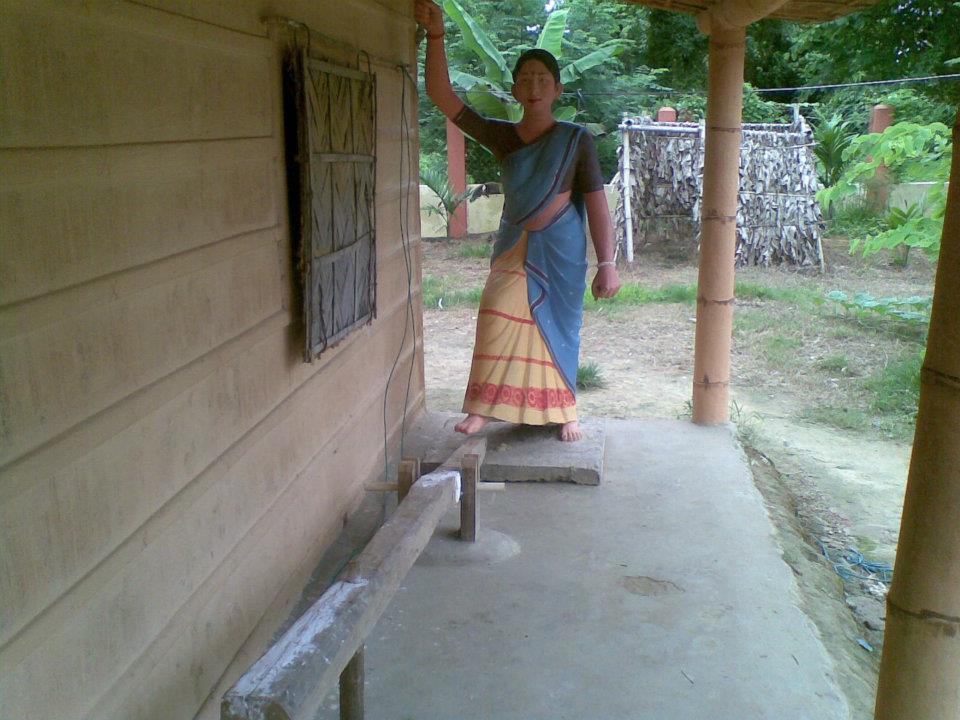dheki on:
[Wikipedia]
[Google]
[Amazon]
 A dheki is an
A dheki is an  A dheki consists of a heavy wooden
A dheki consists of a heavy wooden
 A dheki is an
A dheki is an agricultural
Agriculture or farming is the practice of cultivating Plant, plants and livestock. Agriculture was the key development in the rise of Sedentism, sedentary human civilization, whereby farming of Domestication, domesticated species created food ...
tool used for threshing
Threshing, or thrashing, is the process of loosening the edible part of grain (or other crop) from the straw to which it is attached. It is the step in grain preparation after reaping. Threshing does not remove the bran from the grain.
History ...
, to separate rice
Rice is the seed of the grass species ''Oryza sativa'' (Asian rice) or less commonly ''Oryza glaberrima
''Oryza glaberrima'', commonly known as African rice, is one of the two domesticated rice species. It was first domesticated and grown i ...
grains from their outer husk
Husk (or hull) in botany is the outer shell or coating of a seed. In the United States, the term husk often refers to the leafy outer covering of an ear of maize (corn) as it grows on the plant. Literally, a husk or hull includes the protective ...
s, while leaving the bran
Bran, also known as miller's bran, is the hard outer layers of cereal grain. It consists of the combined aleurone and pericarp. Corn (maize) bran also includes the pedicel (tip cap). Along with germ, it is an integral part of whole grains, ...
layer, thus producing brown rice
Brown rice is a whole grain rice with the inedible outer Rice hulls, hull removed. This kind of rice sheds its outer hull or husk but the bran and germ layer remain on, constituting the brown or tan colour of rice. White rice is the same grain w ...
. Dhekis have generally fallen into disuse because of the availability of technologies such as combine harvester
The modern combine harvester, or simply combine, is a versatile machine designed to efficiently harvest a variety of grain crops. The name derives from its combining four separate harvesting operations—reaping, threshing, gathering, and winnow ...
s that require much less physical labour. In earlier times a dheki was an important part of village life in Bangladesh
Bangladesh (}, ), officially the People's Republic of Bangladesh, is a country in South Asia. It is the eighth-most populous country in the world, with a population exceeding 165 million people in an area of . Bangladesh is among the mos ...
and in parts of India, notably West Bengal
West Bengal (, Bengali: ''Poshchim Bongo'', , abbr. WB) is a state in the eastern portion of India. It is situated along the Bay of Bengal, along with a population of over 91 million inhabitants within an area of . West Bengal is the fourt ...
, Jharkhand
Jharkhand (; ; ) is a state in eastern India. The state shares its border with the states of West Bengal to the east, Chhattisgarh to the west, Uttar Pradesh to the northwest, Bihar to the north and Odisha to the south. It has an area of . It ...
, Assam
Assam (; ) is a state in northeastern India, south of the eastern Himalayas along the Brahmaputra and Barak River valleys. Assam covers an area of . The state is bordered by Bhutan and Arunachal Pradesh to the north; Nagaland and Manipur ...
and Chhattisgarh
Chhattisgarh (, ) is a landlocked state in Central India. It is the ninth largest state by area, and with a population of roughly 30 million, the seventeenth most populous. It borders seven states – Uttar Pradesh to the north, Madhya Prade ...
. It was generally operated by two or three women. A dheki consists of a heavy wooden
A dheki consists of a heavy wooden lever
A lever is a simple machine consisting of a beam or rigid rod pivoted at a fixed hinge, or ''fulcrum''. A lever is a rigid body capable of rotating on a point on itself. On the basis of the locations of fulcrum, load and effort, the lever is div ...
, usually about long, supported on a pedestal about high, which provides a fulcrum. At one end of the lever is a vertical wooden cylinder which functions as a pestle
Mortar and pestle is a set of two simple tools used from the Stone Age to the present day to prepare ingredients or substances by crushing and grinding them into a fine paste or powder in the kitchen, laboratory, and pharmacy. The ''mortar'' () ...
. It is raised by the lever, and that falls down by its own weight. The fulcrum of the lever is placed at five-eighths of the length of the lever from the pestle.
See also
*Mortar and pestle
Mortar and pestle is a set of two simple tools used from the Stone Age to the present day to prepare ingredients or substances by crushing and grinding them into a fine paste or powder in the kitchen, laboratory, and pharmacy. The ''mortar'' () ...
References
Threshing tools {{tool-stub